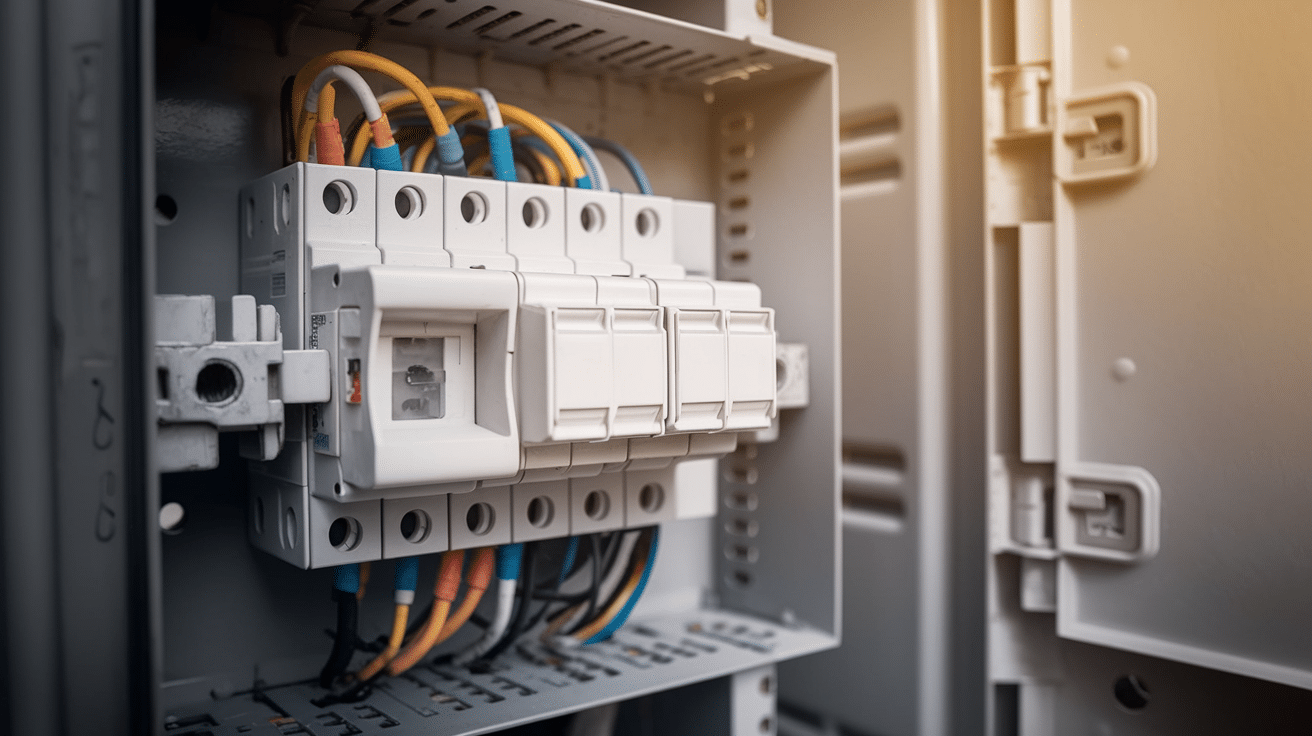What Causes a Tripped Breaker and How to Fix It
Your lights just went out, and you’re standing in the dark wondering what happened.
Circuit breakers trip more often than you think, and it’s usually not just bad luck. Common causes include overloaded circuits, short circuits, and ground faults that can happen in any home.
The good news? Most tripped breakers are easy to fix once you know what to look for. You don’t need to call an electrician for every power outage.
Understanding why breakers trip and how to reset them safely can save you time, money, and stress.
This guide will show you the main reasons breakers trip and give you simple steps to get your power back on. You’ll learn when it’s safe to fix it yourself and when to call a professional.
What is a Tripped Breaker?
A tripped breaker is a safety switch that automatically shuts off power to protect your home’s electrical system from damage. When a breaker trips, it moves to the “off” position and cuts electricity to that specific circuit. This happens when the breaker detects dangerous electrical conditions that could cause fires or damage to your appliances.
The most common reasons breakers trip include:
- Circuit overloads occur when you plug in too many devices and draw more power than the circuit can handle safely.
- Short circuits happen when hot and neutral wires touch each other directly, creating a dangerous surge of electricity.
- Ground faults occur when electricity flows through an unintended path, like water or a person, instead of through the proper wiring.
All these conditions trigger the breaker to trip as a protective measure, stopping the flow of electricity before serious problems can occur.
Signs That Your Breaker Has Tripped
Knowing how to spot a tripped breaker can help you quickly identify and fix power problems in your home. Here are the key signs to look for:
1. Breaker switch position – The tripped breaker will be in the middle position between “on” and “off,” or fully switched to “off”.
2. Partial power loss – Only certain rooms, outlets, or appliances lose power while others continue working normally.
3. Dead outlets – Specific electrical outlets stop working even though other parts of your home have electricity.
4. Appliance shutdown – Large appliances like air conditioners, microwaves, or washing machines suddenly stop running.
5. Light fixtures go dark – Certain light switches or fixtures won’t turn on while lights in other areas work fine.
Common Causes of a Tripped Breaker
Understanding why breakers trip helps you prevent future problems and keep your electrical system running smoothly. Each cause has specific warning signs and solutions that can help you identify the root of the issue.
1. Overloaded Circuit
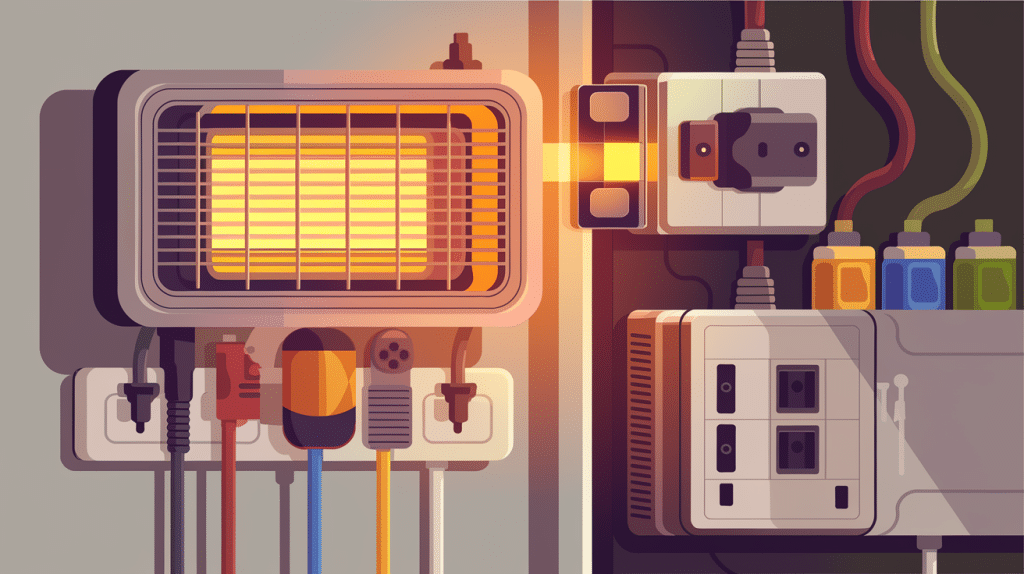
An overloaded circuit happens when you demand more electricity than the circuit can safely provide. This is the most common reason for tripped breakers, especially in older homes with fewer circuits. Modern households use more electrical devices than ever before, making overloads increasingly common.
- Plugging multiple high-power appliances into the same circuit.
- Using extension cords and power strips to add more devices than the circuit was designed for.
- Running space heaters, hair dryers, or other high-wattage items simultaneously.
Note: Most household circuits are rated for 15 or 20 amps – check your breaker panel for the exact rating.
2. Short Circuit
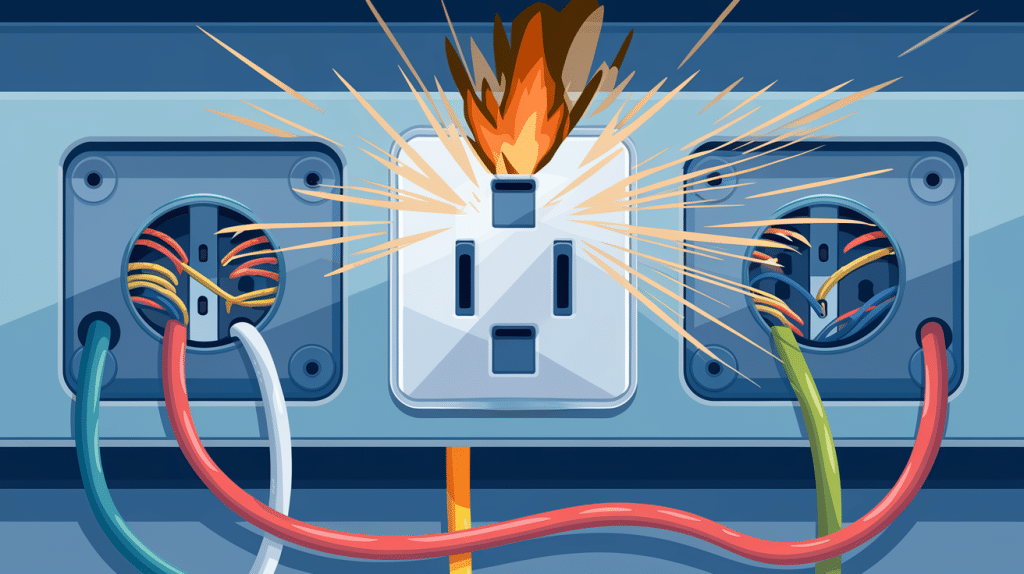
A short circuit creates a direct connection between hot and neutral wires, causing a massive surge of electricity. This dangerous condition generates heat and sparks that can start fires. Short circuits often happen due to damaged wiring, loose connections, or faulty appliances.
- Damaged or frayed electrical cords that expose bare wires.
- Loose wire connections inside outlets, switches, or junction boxes.
- Defective appliances with internal wiring problems.
Note: Short circuits often produce a burning smell or visible sparks – turn off power immediately if you notice these signs.
3. Ground Fault
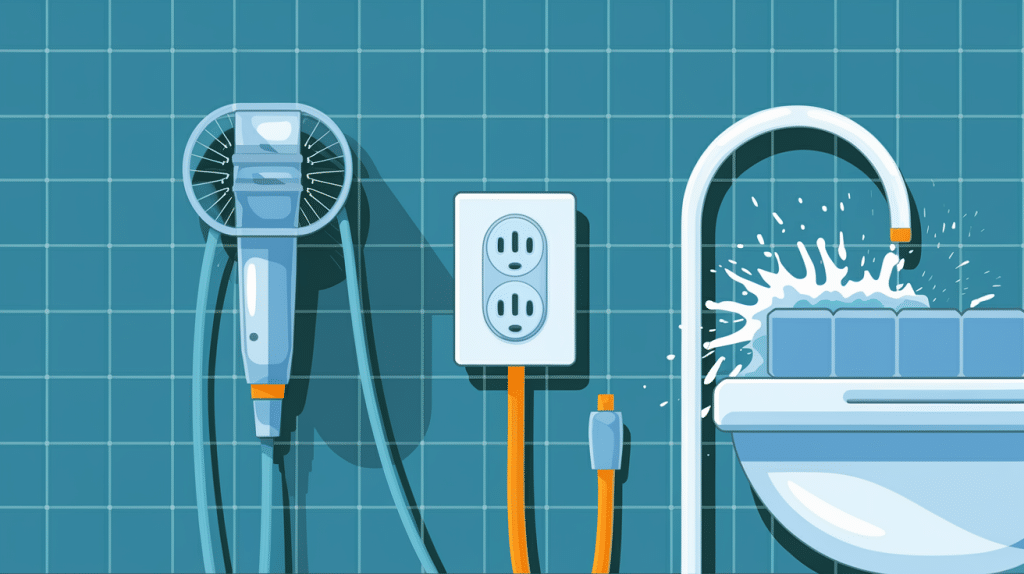
Ground faults occur when electricity flows through water, metal, or a person instead of following its intended path through the wiring. These faults are especially dangerous because they can cause electrical shock. Ground faults commonly happen in wet areas like bathrooms, kitchens, and outdoor spaces.
- Water getting into electrical outlets, switches, or appliances.
- Damaged outdoor wiring exposed to rain or sprinkler systems.
- Faulty appliances that allow electricity to flow through their metal housing.
Note: GFCI outlets and breakers are specifically designed to detect ground faults and trip within milliseconds.
4. Faulty Breaker
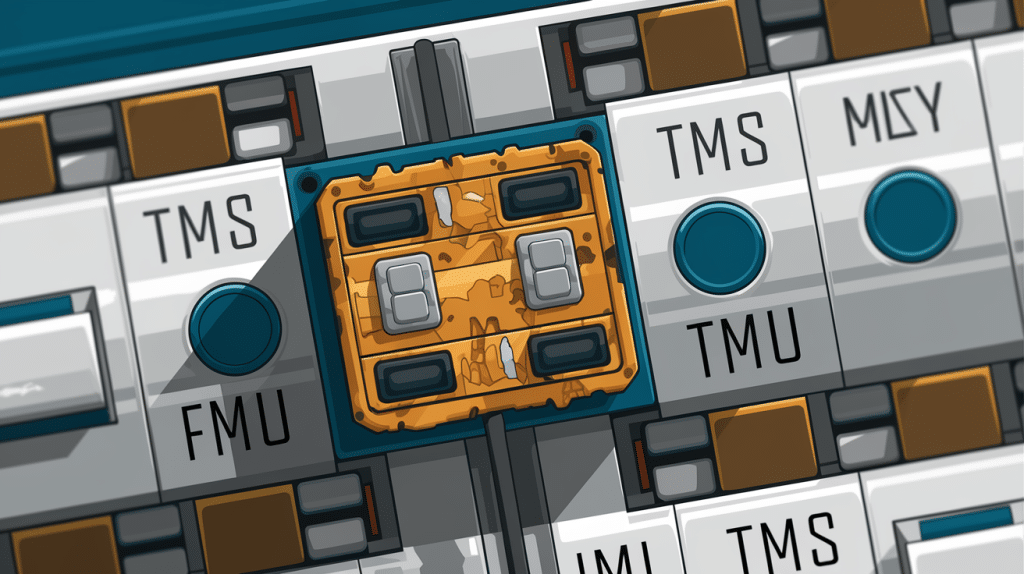
Circuit breakers wear out over time and may start tripping when they shouldn’t. Old breakers lose their ability to accurately detect electrical problems. A faulty breaker might trip repeatedly even when the circuit isn’t overloaded or experiencing other issues.
- Breakers that trip immediately after being reset with no apparent cause.
- Old breakers (over 20 years) that trip more frequently than before.
- Breakers that feel loose or don’t stay firmly in the “on” position.
Note: Replacing a faulty breaker requires turning off main power and should be done by a qualified electrician.
How to Reset a Tripped Breaker?
Resetting a tripped breaker is a straightforward process, but safety should always come first. Following the proper steps ensures you fix the problem without putting yourself at risk or causing further electrical issues.
Pre-Reset Safety Checks:
Before attempting to reset any breaker, you need to identify and address the cause of the trip. Turn off or unplug all devices connected to the affected circuit to prevent immediate re-tripping.
Look for obvious problems like damaged cords, burning smells, or water near electrical outlets. Check if any appliances were running when the breaker tripped, as this can help identify the cause.
Step-by-Step Reset Process:
| Step | Action | Description |
|---|---|---|
| Step 1 | Locate the Tripped Breaker | Locate your electrical panel and identify the breaker that has moved to the middle position or “off” position, which is often marked differently from the others. |
| Step 2 | Turn the Breaker Fully Off | Push the tripped breaker switch completely to the “off” position before attempting to reset it, ensuring a proper reset sequence. |
| Step 3 | Reset to the On Position | Firmly push the breaker switch to the “on” position until you hear or feel it click securely into place. |
| Step 4 | Test the Circuit | Turn on a light or plug in a small device to confirm power has been restored to the affected area. |
| Step 5 | Monitor for Re-Tripping | Watch the breaker for several minutes to ensure it stays in the “on” position and doesn’t trip again immediately. |
Essential Safety Precautions:
Always keep your hands dry and stand on a dry surface when working with electrical panels. Never touch the metal parts of the breaker or electrical panel with wet hands.
If the breaker trips again immediately after resetting, stop and call an electrician – this indicates a serious problem that requires professional attention. Never force a breaker that won’t stay in the “on” position, as this could indicate internal damage or a persistent electrical fault.
What to Do If the Breaker Keeps Tripping
When a breaker trips repeatedly, it indicates a persistent problem that requires attention. Don’t keep resetting it, hoping the issue will go away – this approach can be dangerous and may lead to electrical fires or equipment damage.
1. Identify if There Is an Overload or A Faulty Appliance
- Unplug all devices from the affected circuit and try resetting the breaker.
- Add devices back one at a time to see which one causes the trip.
- Check if high-power appliances like space heaters or hair dryers are running together.
- Look for appliances that make unusual noises, smell burnt, or feel hot to the touch.
- Test each outlet with a simple device like a lamp to identify problem areas.
2. Check the Wiring and Connections for Faults
- Inspect all visible cords for damage, fraying, or exposed wires.
- Look for loose outlet covers or switch plates that might indicate wiring problems.
- Check for scorch marks, discoloration, or burning smells around outlets and switches.
- Ensure no water has gotten into electrical components, especially in bathrooms and kitchens.
- Listen for crackling or buzzing sounds that could indicate arcing wires.
3. Call an Electrician if The Breaker Trips Repeatedly
- Contact a professional if the breaker trips with no devices plugged in.
- Get help when you find damaged wiring or electrical components beyond your skill level.
- Call immediately if you smell burning, see sparks, or notice hot electrical panels.
- Seek professional help if the breaker is old and may need replacement.
- Don’t attempt complex electrical repairs yourself – the risks are too high.
Preventing Future Breaker Trips
1. Distribute high-power devices across different circuits – Avoid plugging multiple heavy appliances like microwaves, space heaters, and hair dryers into outlets on the same circuit to prevent overloads.
2. Use power strips with built-in surge protection – Choose quality power strips that protect against electrical surges and don’t exceed the strip’s rated capacity when plugging in multiple devices.
3. Schedule regular electrical inspections every 3-5 years – Have a qualified electrician check your wiring, outlets, and breaker panel to catch potential problems before they cause trips or safety hazards.
4. Replace old or damaged electrical cords immediately – Inspect all appliance cords regularly and replace any that show signs of wear, fraying, or damage to prevent short circuits and ground faults.
5. Upgrade electrical panels in homes over 30 years old – Consider updating your electrical system if you have an older home with insufficient circuits or outdated breakers that can’t handle modern electrical demands safely.
Conclusion
Tripped breakers are your home’s way of protecting you from electrical dangers. Most trips happen due to overloaded circuits, short circuits, or ground faults that you can often prevent with simple changes.
Resetting a breaker safely involves turning off connected devices, switching the breaker fully off, then back on, and monitoring for repeat trips.
If your breaker keeps tripping, don’t ignore it. Check for faulty appliances and damaged wiring, but call an electrician for persistent problems. Prevention is key – spread high-power devices across different circuits, use quality power strips, and schedule regular electrical inspections.
Remember, electrical safety isn’t worth risking. When in doubt, contact a professional electrician. Your family’s safety is more important than saving money on repairs.
What electrical issues have you dealt with in your home? Share your experiences in the comments below.

